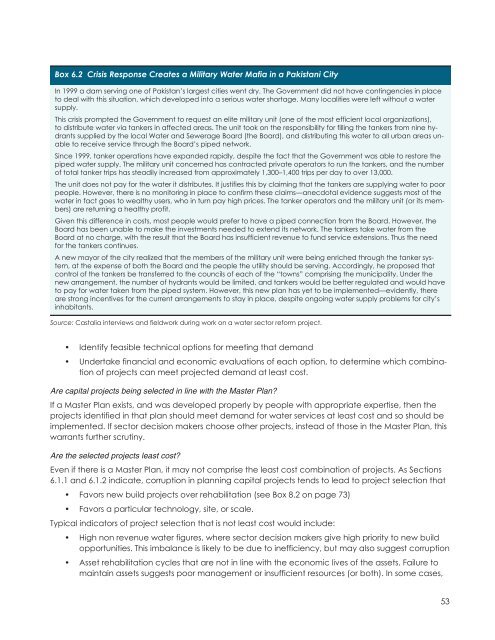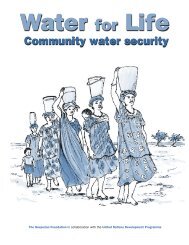A Sourcebook - UN-Water
A Sourcebook - UN-Water
A Sourcebook - UN-Water
Create successful ePaper yourself
Turn your PDF publications into a flip-book with our unique Google optimized e-Paper software.
Box 6.2 Crisis Response Creates a Military <strong>Water</strong> Mafia in a Pakistani City<br />
In 1999 a dam serving one of Pakistan’s largest cities went dry. The Government did not have contingencies in place<br />
to deal with this situation, which developed into a serious water shortage. Many localities were left without a water<br />
supply.<br />
This crisis prompted the Government to request an elite military unit (one of the most efficient local organizations),<br />
to distribute water via tankers in affected areas. The unit took on the responsibility for filling the tankers from nine hydrants<br />
supplied by the local <strong>Water</strong> and Sewerage Board (the Board), and distributing this water to all urban areas unable<br />
to receive service through the Board’s piped network.<br />
Since 1999, tanker operations have expanded rapidly, despite the fact that the Government was able to restore the<br />
piped water supply. The military unit concerned has contracted private operators to run the tankers, and the number<br />
of total tanker trips has steadily increased from approximately 1,300–1,400 trips per day to over 13,000.<br />
The unit does not pay for the water it distributes. It justifies this by claiming that the tankers are supplying water to poor<br />
people. However, there is no monitoring in place to confirm these claims—anecdotal evidence suggests most of the<br />
water in fact goes to wealthy users, who in turn pay high prices. The tanker operators and the military unit (or its members)<br />
are returning a healthy profit.<br />
Given this difference in costs, most people would prefer to have a piped connection from the Board. However, the<br />
Board has been unable to make the investments needed to extend its network. The tankers take water from the<br />
Board at no charge, with the result that the Board has insufficient revenue to fund service extensions. Thus the need<br />
for the tankers continues.<br />
A new mayor of the city realized that the members of the military unit were being enriched through the tanker system,<br />
at the expense of both the Board and the people the utility should be serving. Accordingly, he proposed that<br />
control of the tankers be transferred to the councils of each of the “towns” comprising the municipality. Under the<br />
new arrangement, the number of hydrants would be limited, and tankers would be better regulated and would have<br />
to pay for water taken from the piped system. However, this new plan has yet to be implemented—evidently, there<br />
are strong incentives for the current arrangements to stay in place, despite ongoing water supply problems for city’s<br />
inhabitants.<br />
Source: Castalia interviews and fieldwork during work on a water sector reform project.<br />
• Identify feasible technical options for meeting that demand<br />
• Undertake financial and economic evaluations of each option, to determine which combination<br />
of projects can meet projected demand at least cost.<br />
Are capital projects being selected in line with the Master Plan?<br />
If a Master Plan exists, and was developed properly by people with appropriate expertise, then the<br />
projects identified in that plan should meet demand for water services at least cost and so should be<br />
implemented. If sector decision makers choose other projects, instead of those in the Master Plan, this<br />
warrants further scrutiny.<br />
Are the selected projects least cost?<br />
Even if there is a Master Plan, it may not comprise the least cost combination of projects. As Sections<br />
6.1.1 and 6.1.2 indicate, corruption in planning capital projects tends to lead to project selection that<br />
• Favors new build projects over rehabilitation (see Box 8.2 on page 73)<br />
• Favors a particular technology, site, or scale.<br />
Typical indicators of project selection that is not least cost would include:<br />
• High non revenue water figures, where sector decision makers give high priority to new build<br />
opportunities. This imbalance is likely to be due to inefficiency, but may also suggest corruption<br />
• Asset rehabilitation cycles that are not in line with the economic lives of the assets. Failure to<br />
maintain assets suggests poor management or insufficient resources (or both). In some cases,<br />
53
















